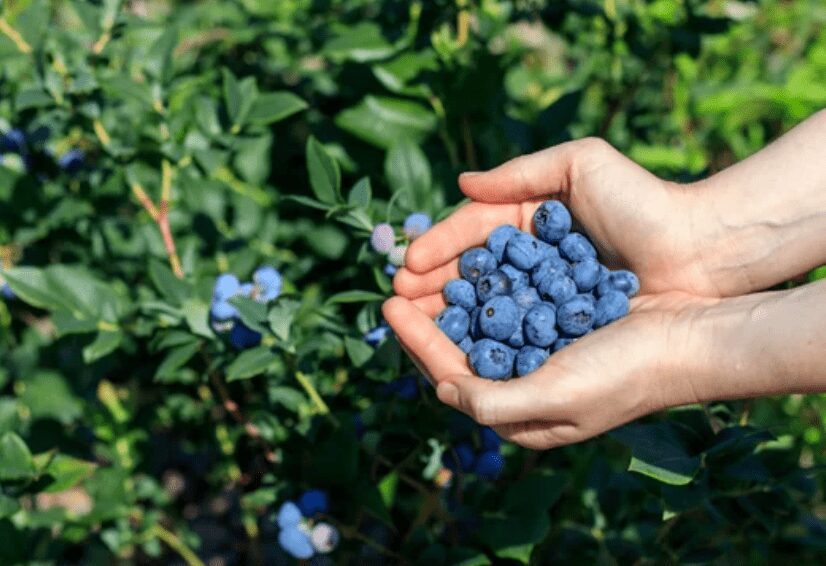
Are you looking for comprehensive guidance on how to grow blueberries indoors and outdoors? You’re in the right place. Our thorough guide covers every aspect of cultivating these delightful berries, whether you’re an urban gardener with a windowsill planter or a rural enthusiast with acres to spare.
From selecting the suitable variety and preparing the perfect soil to ongoing care and troubleshooting common problems, we’ll walk you through the rewarding process of growing blueberries.
Discover the joy of harvesting your own fresh, succulent blueberries and enjoy the bonus of their ornamental beauty in your living space or garden.
So let’s dive in and explore the world of blueberry cultivation, a gratifying and fruitful hobby in the truest sense of the word.
Choosing the Right Variety
There are many varieties of blueberries, but not all are suitable for growing indoors or in containers. The best ones are dwarf or semi-dwarf varieties with a compact habit and tolerate different climates.
Some examples are:
Top Hat Blueberries
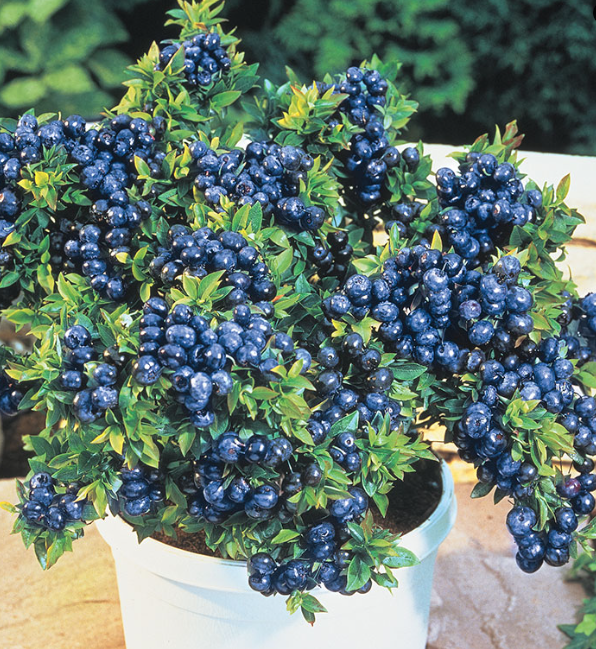
Top Hat blueberries, also known as Vaccinium ‘Top Hat,’ are a wide variety of dwarf blueberry bushes particularly suitable for container gardening or small spaces. They typically grow to a height and width of 1-2 feet, making them a perfect fit for patios, balconies, or small garden plots. This low-maintenance variety is self-pollinating, which means you only need one plant to produce fruit.
Despite their small size, Top Hat blueberries are known for their generous yield of small to medium-sized berries, sweet and tart in taste, ideal for fresh eating, baking, or making preserves. The fruiting period typically occurs in mid to late summer.
However, the enjoyment of these plants extends beyond their fruiting phase; in the spring, they display beautiful white blossoms, while in the fall, the foliage turns into an attractive bronze color, making them an aesthetically pleasing addition to any garden throughout the year.
Top Hat blueberries prefer acidic soil with a pH of 4.5-5.5, full sun to partial shade, and regular watering. They also require winter chill for optimal fruit production.
Overall, with proper care, including annual pruning and appropriate fertilization, Top Hat blueberries can provide a bountiful harvest despite their compact size and add beauty to your outdoor space.
Northsky
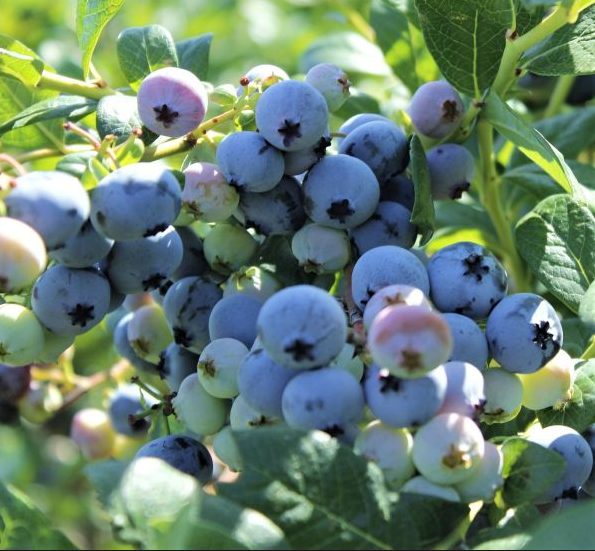
Northsky blueberries, a variety of the Vaccinium corymbosum species, are an exceptional choice for cold-climate gardening. These compact, semi-dwarf bushes usually grow to a height of about 1.5 to 2.5 feet, making them suitable for small garden spaces and container gardening.
They are recognized for their cold-hardiness, capable of withstanding temperatures down to -45 degrees Fahrenheit, making them a perfect fit for regions with harsh winters.
Northsky blueberries produce a reliable yield of small to medium-sized berries with an excellent, sweet flavor. Typically, the harvesting period is around midsummer. Notably, the bushes also add visual interest to a garden.
In spring, the bushes are adorned with delicate, bell-shaped white to pink flowers. In the fall, their leaves turn from green to a vibrant red, providing a striking landscape feature.
Like all blueberries, Northsky bushes prefer well-draining, acidic soil with a pH between 4.5 and 5.5. They thrive in full sun but can tolerate partial shade. Consistent watering is essential, particularly during dry periods, but care should be taken to avoid waterlogging the soil.
With their resilient nature and rewarding yield, Northsky blueberries are a delightful addition to any home garden.
Northblue Blueberries
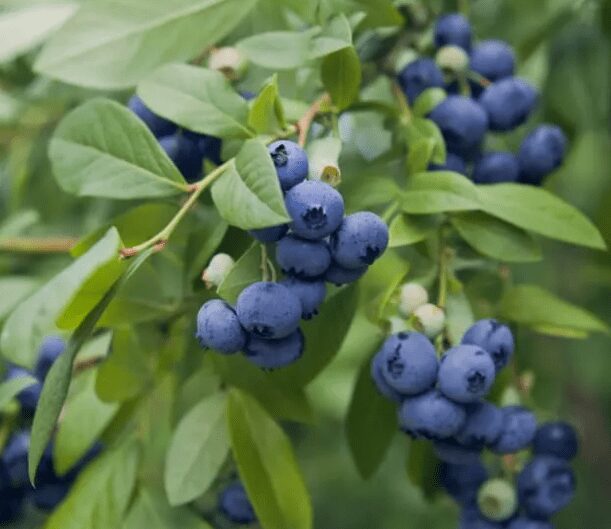
NorthBlue blueberries are a half-high blueberry bush, a cross between highbush and lowbush varieties, bred for their superior cold hardiness, making them ideal for northern climates. These compact bushes grow to about 2-3 feet, suitable for small gardens, landscapes, or container cultivation.
NorthBlue blueberries are prized for their large, dark blue berries that boast a sweet, wild blueberry flavor with a hint of tartness. The fruiting period typically occurs in mid-summer, and the plants can yield up to 3-7 pounds of berries per mature bush, which is quite prolific considering their modest size.
In addition to their delicious fruit, NorthBlue blueberry bushes offer ornamental value throughout the year. In spring, they produce clusters of white, bell-shaped flowers, and their dark green foliage turns into a spectacular display of burgundy red in the fall.
Like other blueberry varieties, NorthBlue blueberries thrive in well-drained, acidic soil with a pH between 4.5 and 5.5. They prefer full sun to partial shade and need regular watering, especially during dry spells. Their high cold tolerance, manageable size, and generous yield make NorthBlue blueberries an excellent choice for gardeners in cooler climates.
Sunshine Blue Blueberries
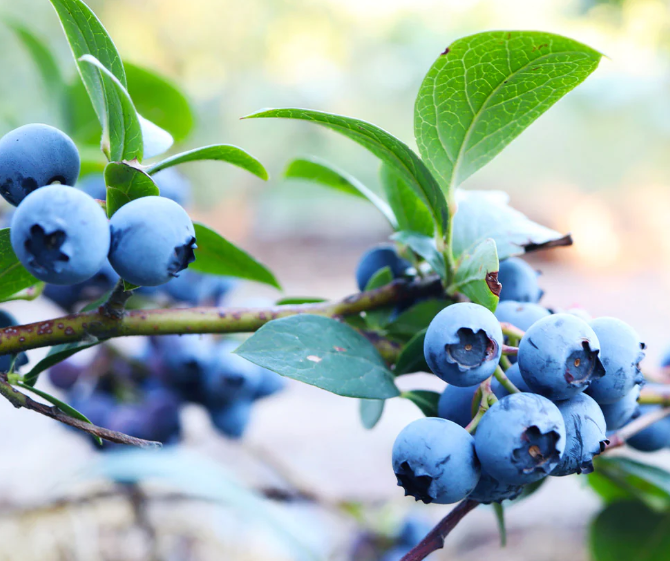
Sunshine Blue blueberries are a widespread variety of southern highbush blueberries. They are highly valued for their ability to grow well in warmer climates, with a low chilling requirement of only 150 hours, and the number of cold temperatures a plant must produce correctly. This makes them an excellent choice for areas with mild winters.
Sunshine Blue blueberry bushes typically grow to a manageable height of 3-4 feet, making them ideal for container gardening or smaller garden spaces. One of the distinct features of this variety is its semi-evergreen foliage that provides year-round visual interest. The leaves are dark green and glossy during the growing season, turning to a striking reddish-purple in cooler weather.
The berries of the Sunshine Blue are medium-sized, firm, and have a delightful sweet-tart flavor. They ripen over a long season, often from late spring through summer, providing a prolonged harvest. Despite their compact size, these bushes can be pretty productive, often yielding 5-10 pounds of berries per plant when mature.
Regarding growing conditions, Sunshine Blue blueberries prefer well-draining, acidic soil with a pH between 4.5 and 5.5. They enjoy full sun but can tolerate partial shade. Regular watering is crucial, but they are notably drought-tolerant compared to other blueberry varieties. Sunshine Blue blueberries are a wonderful addition to any home garden with their adaptability, attractive aesthetics, and delicious fruit.
Planting Blueberries
Whether you plant blueberries indoors or outdoors, you must prepare the soil, the pot, and the plant.
Preparing the Soil
Blueberries prefer acidic, sandy soil with a pH of 4.5 to 5.5. You can buy acidic potting mix from a garden center or make your own by mixing peat moss, pine bark, and perlite in equal parts. You can also add some organic fertilizer or compost to enrich the soil.
Preparing the Pot
Choose a pot at least 12 to 18 inches deep and wide, with drainage holes at the bottom. Fill it with the prepared soil, leaving some space at the top for watering. You can also place a saucer under the pot to catch excess water.
Preparing the Plant
Buy a healthy blueberry plant from a nursery or online. Look for one with green leaves, sturdy stems, and no signs of disease or pests. If you buy a bare-root plant, soak it in water for an hour before planting. If you buy a potted plant, gently loosen the root ball before planting.
Dig a hole in the center of the pot that is as deep and wide as the plant’s root ball. Place the plant in the hole and spread the roots evenly. Fill the hole with soil and press it firmly around the plant. Water thoroughly until water drains out of the bottom of the pot.
Caring for Blueberries
Blueberries are low-maintenance plants that only need some primary care to thrive.
Watering
Water your blueberry plant regularly to keep the soil moist but not soggy. Check the soil with your finger before watering; if it feels dry an inch below the soil surface above, it’s time to water. Avoid overwatering or underwatering, as both can cause stress and reduce fruit production.
Fertilizing
Feed your blueberry plant with an acidic fertilizer once in spring and once in summer. Follow the instructions on the label for how much and how often to apply. You can also use organic fertilizers like fish emulsion or compost tea.
Pruning
Prune your blueberry plant once a year in late winter or early spring before new growth starts. Remove dead, diseased, or damaged branches and weak or crossing ones. Cut back about a third of the oldest stems to encourage new growth and fruiting.
Harvesting
Harvest your blueberries when fully ripe, usually from May to August, depending on the variety. Ripe blueberries are plump, firm, and blue all over; they should come off quickly when gently tugging them. Pick them regularly to avoid overloading the plant and attracting birds or pests.
Enjoy your fresh blueberries as they are, or use them in pies, muffins, smoothies, salads, or jams. You can also freeze them for later use; wash them, dry them, spread them on a baking sheet, and freeze them until solid. Then transfer them to a freezer bag or container and store them for up to a year.
Growing Blueberries Indoors vs. Outdoors
Growing blueberries indoors has some advantages over growing them outdoors:
– You can control the temperature, light, and humidity better indoors.
– You can protect your plants from frost, wind, rain, pests, and diseases better indoors.
– You can enjoy fresh blueberries year-round indoors.
However, growing blueberries outdoors also has some benefits:
– You can save space plants grow well indoors by growing other plants that need warmth or light.
– You can take advantage of natural sunlight outdoors.
– You can pollinate your plants more easily outdoors with bees or other insects.
Whether you grow blueberries indoors or outdoors depends on your preference and situation. Either way, you can have fun growing these tasty fruits at home!
How To Grow Blueberries Outdoors
Blueberry plants can be a rewarding addition to your home garden. This versatile and nutritious fruit thrives best in cool climates and certain specific conditions. To grow blueberries outside, choose the suitable variety suited for your climate.
High bush varieties are typically ideal for more relaxed, northern environments, while rabbiteye and southern high bush types fare better in warmer southern temperatures.
Timing
The optimal time to plant blueberries is late winter or early spring. Start by selecting a sunny location with well-drained soil, as blueberries enjoy full sun and can become susceptible to root diseases in overly saturated soil.
Test the soil before planting since blueberries require acidic soil with a pH between 4.5 and 5.5. If the soil pH is below this range, you can lower it by adding elemental sulfur or other soil acidifiers.
Planting
When planting, dig a hole about twice as wide and the same depth as the root ball of your blueberry bush. Place the plant in the hole, then fill in around it with a mix of the original soil and an acidifying organic matter like peat moss, compost, or even pine needles and bark.
After planting, water thoroughly and add a layer of organic mulch around the base of the plant to retain moisture and inhibit weed growth.
Blueberries have shallow root systems that benefit from consistent soil moisture throughout, so regular watering is essential, particularly during dry periods. Fertilize with a portion of balanced acid-loving plant food in the early spring, just before leaf break, and after harvesting the berries to promote vigorous growth.
Pruning
Pruning is also an essential part of blueberry care. During the first few years, you should remove all blossoms to discourage fruit production and encourage the plant to focus its energy on developing a solid root system.
In subsequent years, prune during the dormant season, removing weak or dead branches to promote the growth of solid and productive branches.
Pest Control
Regarding pest control, blueberries can be susceptible to insects such as blueberry maggot and spotted wing drosophila, as well as diseases like mummy berry and botrytis blight. Implementing an integrated pest management strategy, including regular observation, beneficial insects, and targeted organic pesticide use, can help keep your plants healthy if necessary.
Finally, patience is essential when growing blueberries, as most plant blueberry bushes often will produce an entire crop in their third or fourth year. With proper care, however, your blueberry plants can provide you with a bountiful harvest for years.
Plant Growth Cycle & Yields
Blueberry plants follow a similar growth cycle to most fruit-bearing plants but with some unique aspects. Understanding these stages of shoot growth and their timeline will help maximize your blueberry yields.
Dormancy:
Blueberry bushes lie dormant in winter. They require several “chill hours” at temperatures below 45°F (7°C) to ensure healthy bud development. This requirement can range from 200 to 800 hours, depending on the variety.
Bud Break:
As temperatures rise in late winter to early spring, the dormant buds on the blueberry bush swell and open. Leaves emerge first, flower buds, followed by the blossoms.
Blossoming and Pollination:
The flowers bloom in spring, attracting bees and other pollinators. Each flower has the potential to become a blueberry if it is pollinated. This stage is crucial, and weather conditions play a significant role. If temperatures drop too low, the blooms could be damaged, reducing the yield for the growing season.
Fruit Development:
Once pollinated, the flower petals fall off, and the fertilized ovule develops into a blueberry. The berries begin as small green fruits and gradually grow and change color, typically to a deep blue.
Harvesting
Blueberries typically ripen about 2 to 3 months after the flowering stage. The exact time varies based on variety and local climate conditions. The berries do not all ripen at once, which allows for multiple pickings over several weeks.
Post-Harvest
After harvesting, the plant shifts its energy to root development and preparation for dormancy. Leaves will change color and fall off as winter approaches, and the cycle begins again.
The yield of a highbush blueberry plant per plant varies depending on its age, variety, care, and environmental conditions. Generally, a highbush blueberry plant starts bearing fruit in its third year, producing about 5-6 pounds annually.
Rabbiteye blueberry varieties can yield as much as 15 pounds per mature plant in a good year. However, it takes a few years for the plant to reach full production – patience and care are vital in maximizing your blueberry yields.
Final Word
In cultivating blueberries indoors and outdoors, there’s an impressive variety to explore, from lowbush and highbush types to rabbiteye blueberries and even hybrids like half-high blueberries.
Whether starting with blueberry seeds or young plants like bare root plants from your local garden center or nursery, success begins with understanding their unique needs.
Blueberries are acid-loving plants that thrive in acidic soils with a pH typically between 4.5 and 5.5; getting your soil pH tested is crucial, and amendments like sphagnum peat moss, garden sulfur, or even ammonium sulfate may be needed to adjust it.
For planting, a sunny location is ideal, and if you’re working in a garden, raised beds are excellent, especially if drainage is an issue. Plant seeds or young plants about 4-6 feet apart in the ground or in a nursery pot if you opt for container-grown blueberries.
Ensure the planting hole is deep and wide enough to keep the soil loose and roots spread out, and consider using pine bark, wood chips, or sawdust mulch to conserve moisture, control weeds, and slowly release soil nutrients.
Careful pruning of blueberries, particularly of older plants, removing dead wood and thin stems, stimulates new shoots and leads to better berry yields. But hold off in the first two to three years to allow young plants to establish.
Disease development, such as leaf spot diseases or Phytophthora root rot, can be kept at bay with good site selection, ensuring sufficient air movement and avoiding waterlogged soils. For pests, watch for common threats like insect pests or birds, and take preventative measures as needed.
Blueberries are self-fertile, but planting two or more bushes of different varieties can ensure cross-pollination for larger fruit size and higher yield. Depending on the variety, the harvest season can vary from early to mid-summer, with some late-season types, even into fall.
Wild blueberries or some newer cultivars might surprise you with pink berries, but most will turn from green to a deep blue with a waxy bloom. Blueberries are suitable for almost every region, from the coldest climates of North America and Canada to the heat of southern gardens.
Finally, patience pays off. It might take at least a couple of years for your plants to start producing a large harvest of tasty fruit, but the journey is a joy. From the burst of new leaves in the spring, the promise of blossoms turning into big berries in summer, to the red, yellow, and brown hues of blueberry leaves in fall and the anticipation of another growth begins as winter winds down. Every step is a lesson in nature’s rhythm.
Happy gardening!


























